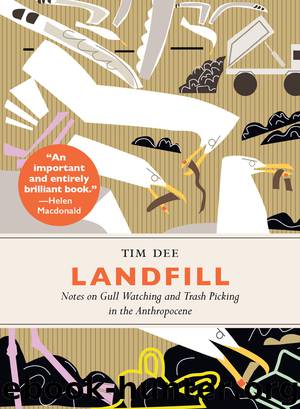Landfill: Notes on Gull Watching and Trash Picking in the Anthropocene by Tim Dee

Author:Tim Dee
Language: eng
Format: epub
Publisher: Chelsea Green Publishing
Published: 2019-03-12T00:00:00+00:00
Jonathan Livingston Seagull
To study the cultural presence of gulls, the uses we have put them to, is to come upon strikingly opposing representations. Gulls have been identified with purity and with danger, with sublimity and with filth. Like pigeons, we’ve granted them a contrary status in our bestiaries, where they have become useful projections for our ambiguities about who we are. Gulls and pigeons are both holy and hated. The winged rat can be the homecoming friend; a dove can be a peace emblem or a stand-in for the Holy Ghost. The gull can be a consummate flyer or a predatory glutton, an instructor of grace or a depraved hooligan.
I hated Jonathan Livingston Seagull for years before I read it. It arrived as a bestseller as I was getting serious about birds. Published in the USA in 1970, it first appeared in the UK in 1972, and invented the feel-good/win-out/learn-from-nature book. Thousands, perhaps millions, were sold.
In 1972 I was an eleven-year-old ornithological zealot. I saw enough of the little blue book to know it was poisonous. It used the nonce word, seagull; it gave a bird a name that wasn’t its common or scientific one; it attributed speech and human thought to its subjects; worst of all, it plastered the whole with a meaning quite other than what gulls surely would countenance.
In many ways I feel now as I did then. Jonathan Livingston Seagull robbed the gulls of America of their own truth. It stole their gullitude and colonised or domesticated the birds even as it constructed a fable around their real aerial mastery.
Both its author and its photographer were flyers. Richard Bach had been a US Air Force pilot, and was, the blurb tells us, ‘now seldom without an airplane’; Russell Munson owned a Piper Super Cub, ‘from which he took some of the pictures in this book’. Both looked hard and jealously at the gulls they described and photographed. As a jump-jet enthusiast might, Bach has a good description of a gull beating its wings to stall or halt in the air and then dropping down lightly to land on a beach. But, beyond the airmen’s envy, their looking is put to cod ends.
The book begins with the young Jonathan practising his flying; he’s already singular and a loner, ‘no ordinary bird’.
For most gulls, it is not flying that matters, but eating. For this gull, though, it was not eating that mattered but flight.
His mother urges him to be like the flock, but he is ‘off by himself’, learning about speed and getting good at flying faster than the other gulls. But trying to set ‘a world speed record for seagulls’ he crashes ‘into a brick-hard sea’. This crisis sends him back to the flock and he tries to rejoin it and be ‘a normal gull’. But he cannot deny his deeper drive; he must be true to his gift, and off he flies again.
Already Jonathan is far from bird. He flies upside down, ‘the first aerobatics of
Download
This site does not store any files on its server. We only index and link to content provided by other sites. Please contact the content providers to delete copyright contents if any and email us, we'll remove relevant links or contents immediately.
| Amphibians | Animal Behavior & Communication |
| Animal Psychology | Ichthyology |
| Invertebrates | Mammals |
| Ornithology | Primatology |
| Reptiles |
Sapiens: A Brief History of Humankind by Yuval Noah Harari(13920)
The Tidewater Tales by John Barth(12372)
Mastermind: How to Think Like Sherlock Holmes by Maria Konnikova(6895)
Do No Harm Stories of Life, Death and Brain Surgery by Henry Marsh(6659)
The Thirst by Nesbo Jo(6407)
Why We Sleep: Unlocking the Power of Sleep and Dreams by Matthew Walker(6301)
Life 3.0: Being Human in the Age of Artificial Intelligence by Tegmark Max(5147)
Sapiens by Yuval Noah Harari(5094)
The Longevity Diet by Valter Longo(4835)
The Body: A Guide for Occupants by Bill Bryson(4539)
The Rules Do Not Apply by Ariel Levy(4485)
The Immortal Life of Henrietta Lacks by Rebecca Skloot(4224)
Why We Sleep by Matthew Walker(4171)
Animal Frequency by Melissa Alvarez(4126)
Yoga Anatomy by Kaminoff Leslie(4085)
The Hacking of the American Mind by Robert H. Lustig(4051)
All Creatures Great and Small by James Herriot(3951)
Barron's AP Biology by Goldberg M.S. Deborah T(3925)
Double Down (Diary of a Wimpy Kid Book 11) by Jeff Kinney(3874)
